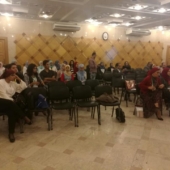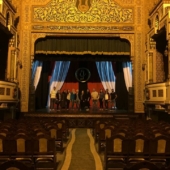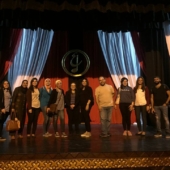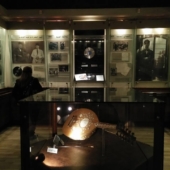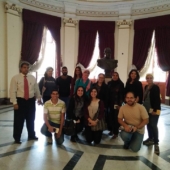BECAMI Opening seminar took place on the 13th of November 2016 at the Greater Cairo Library in Zamalek. It was followed by site visits to the twelve selected museums on the 14th and 15th of November.
Opening session
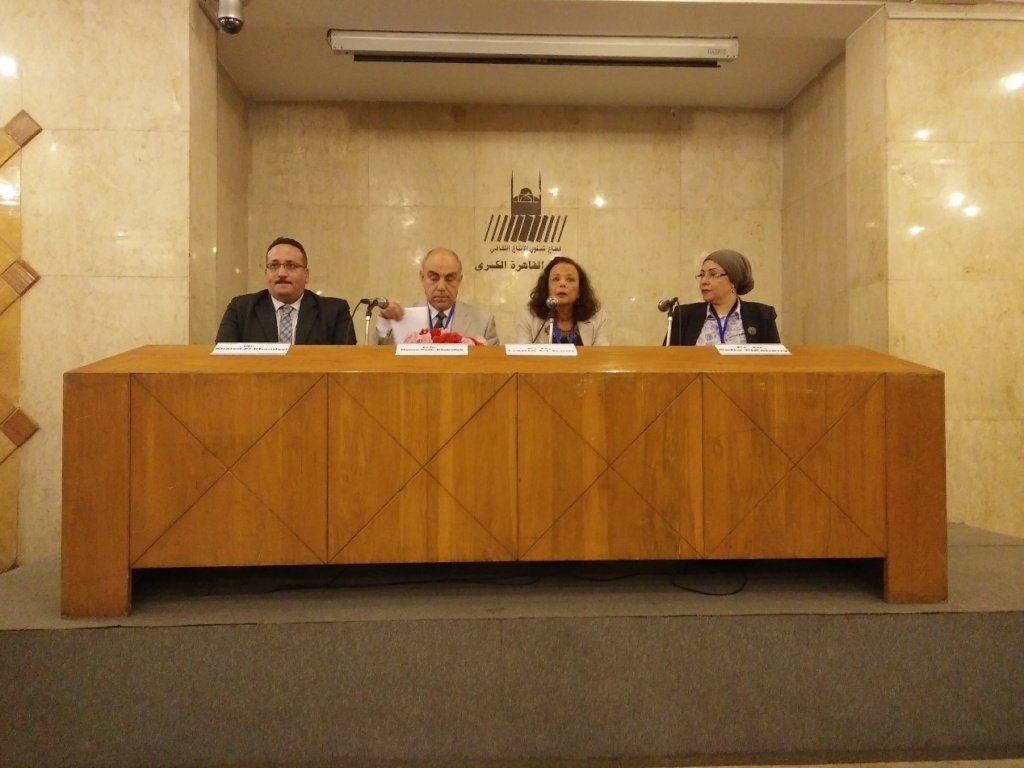
The Opening session started with a brief welcoming note from Dr. Hassan Nadir Keirallah (President of the French University in Egypt, UFE) who stressed on the importance the BECAMI project on the national and international levels, particularly in enhancing collaborative research between Egypt and the UK. Dr. Safia El Kabany (Dean of the Faculty of Fine Arts, Helwan University) spoke about the history of the School of Fine Arts, founded by Prince Yusuf Kamal (1891-1971) in 1908. The School was first established in Darb al-Gamamiz in Historic Cairo, then relocated in several venues across the city, until 1935 where it was housed in its current location in Zamalek. An endowment (waqf) was created by Prince Yusuf Kamel to support under privileged students, which demonstrates how religion and arts are not contested. Mr. Yasser Osman (Director of Greater Cairo Library) spoke on behalf of Mr. Khaled al-Khamissi (President of Greater Cairo Library) and reminded the audience that the library is also housed in a palace built in the Belle Époque, in 1902. It was later bought in 1924 by Princess Samiha, daughter of Sultan Hussein Kamil (r. 1914-1917), who donated it in 1984 to the Egyptian State, with the aim of transforming it into a cultural hub for the public. The palace was renovated and reopened in 1992 as the Greater Cairo Library.
The seminar was divided into three sessions which discussed and debated on the use of innovative methods to preserve Cairo’s Cultural Museums, representing a significant period of Egypt’s past, now forgotten.
First session
Museums as Vectors for Enhancing Heritage Awareness and Consolidating the Identity
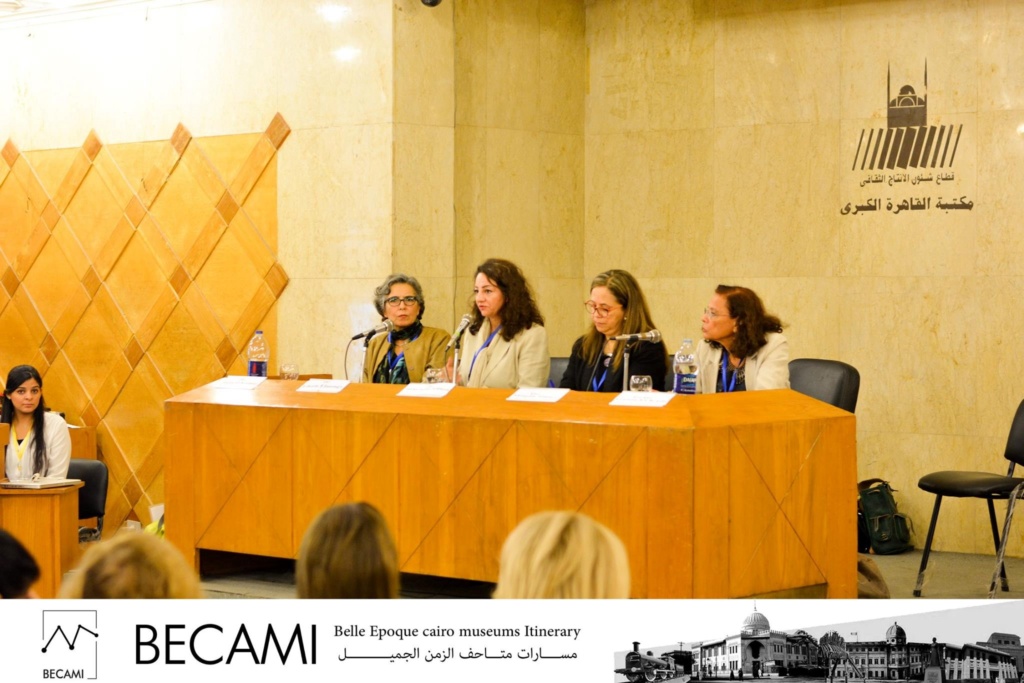
| Moderator | Dr. Heba Safey Eldeen, Professor of Architecture, Fine Arts at Helwan University |
| Participants | Dr. Galila El Kadi, BECAMI – Egypt PI, Professor of Urban Planning, UFE |
| Dr. Dalila El Kerdany, Professor of Architecture, Polytechnic at Cairo University | |
| Dr. Magda Sibley, BECAMI – UK PI, Senior Lecturer, School of Architecture at Sheffield University |
Prof. El Kadi introduced the BECAMI project and how the idea immerged while visiting some museums in 2008. Although the museums have diverse and rich collections, but they were unknown to most of the public. Therefore, a proposal was submitted to the AHRC/ STDF call, which was selected for funding in 2016. El Kadi explained the project’s approach to conserving the cultural heritage of the liberal era in Egypt (1840-1950). BECAMI focuses on the years 1922 to 1936, as they witnessed major political events which were reflected on the cultural life. The museums selected cover different areas and were classified as: 1- Arab Music Pioneers (Museums of Umm Kulthum and Abd al-Wahab), 2- Pioneers of Literature and Poetry (Museums of Taha Hussein and Ahmad Shawki), 3-Transportation and Communication (Museums of Railways and Post), 4- Political and National Leaders (Saad Zaghloul/Bayt 5-al-Umma, Prince Muhammad Ali/Manial Palace and Talaat Harb/Banque Misr), 5-Thematic (Ethnographic Museum/Egyptian Geographical Society, Agricultural Museum and the Fine Arts Museum). The museums are housed in building with historic, architectural and symbolic values. El Kadi explained how the museums are displaying important collections presenting Egypt’s modern history and emphasized on their role in education along with libraries and schools. Since the project is tailored to address students of all ages, it will contribute in strengthening their national identity. BECAMI is designed for them and will be delivered with their participation and engagement. She explained that the project’s main objective is to establish a virtual and physical itineraries linking the museums, as well as a website to create a digital platform for networking. She also suggested a new campaign idea, to have a sponsor for each museum.
Dr. Magda Sibley introduced the ‘Museum Twinning’ as a concept for public engagement through internet and social media. She stressed on the fact that museums are catalysts for urban development. The BECAMI project aims to create an emotional ownership and a sense of belonging between the public and its heritage. She presented ideas for museum twinning. Per example: The Arab Music Pioneers museums (Umm Kulthum and Abd al-Wahab) can be twinned with Pop music museums (The Beatles), this would engage music fans and the younger generations. The Egyptian Railways Museum in Cairo and the National Railways Museum in York is another example which documents the early transportation technologies. Such twinning can open opportunities for research and design for architectural education, marketing, communication and conservation.
Prof. Dalila ElKerdany explained how the approach for planning museums in Egypt still needs revisions, especially when looking at their role in sustainable development. She recalled how Egypt was among the first nations to erect museums for the objects found on archaeological sites. Building museums in Egypt has been an active movement for antiquity and culture. However, they are still not playing their role in education and cultural development. Dr. Elkerdany argued on the evolving role of museums as social cultural hubs, and how it has been changing and overlapping due to their contribution and engaging with local communities, in scenography, education and development. Dr. Elkerdany presented three museums, two in Cairo (The Royal Carriages Museum in Bulaq and the Muhammad Ali Family Collection in the Citadel) and one in Minya (The Akhenaton Museum). She was responsible to design an adaptive reuse to create awareness. She reviewed their role in presenting Egypt’s historic culture and in shaping identities. She described how the museums were transformed from neglected buildings to state of the art museums. Prof ElKerdany emphasised on the roles played by a museum which can lead to a market-driven industry; a location for preserving antiquities and historic collections, a self-income-generating building that would develop its environs, an attractive focal point for its community, and a place for children and special needs education and activities. She concluded with recommendations and remarks on the challenges facing museum planning in Egypt.
Second session
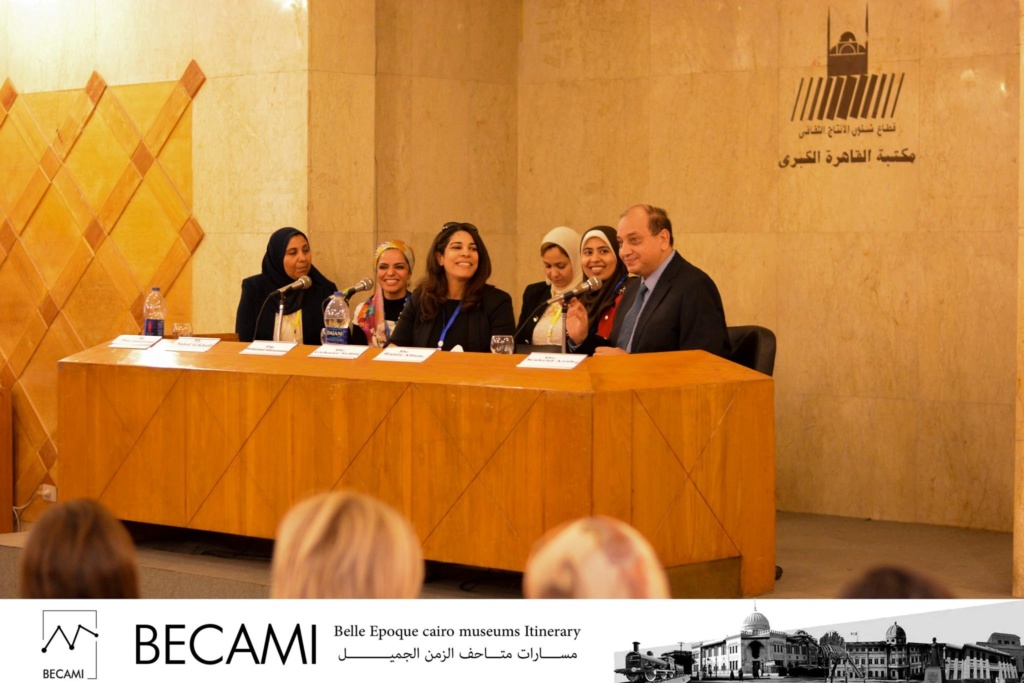
| Moderator | Dr. Gehan Selim, BECAMI – UK Co-Investigator, Lecturer, School of Architecture at Queen university |
| Participants | Dr. Khaled Azab (ICOM, Egypt) |
| Dr. Rania Allam (ICOM, Egypt) | |
| Dr. Hidi Shalaby, NOUH – Natural Organisation for Urban Harmony | |
| Dr. Doaa Aboulmagd, BECAMI – Egypt Co-Investigator, Lecturer of Architecture, Fine Arts at Helwan University | |
| Ms. Nahed al-Khatib, Director of the Railways Museum |
Dr. Azab shared the first talk with Dr. Allam and explained the structure of museums management in Egypt, with 140 museums in total divided between: The Ministry of Culture (37), the Ministry of Tourism and Antiquities (25) and other ministries, along with governmental and non-governmental institutions. The most alarming situation is with the Egyptian Geographical Society which is in danger of collapse. Most of the museums have accessibility and visibility problems. Locations are not always appropriate. Per example, the NMEC (National Museum for Egyptian Civilisation) now in Fustat should have been in Hurgada on the red sea. The textile museum now in Historic Cairo, should have been in al-Mahalla al-Kubra, Egypt’s industrial textile city. Azab and Allam highlighted the lack of proper regulations for protecting museums as the regulations in place are outdated. Azab also emphasised on the lack of proper management and sensible administrative hierarchy for museums, which operates under top-down centrality of decision-making. He concluded that there is a need for new technologies to preserve Egypt’s forgotten heritage, and an urgent need to revitalize museums through the engagement of the private ad the civil society.
Dr. Hidi Shalaby spoke on behalf of Eng. Mohamed Abouseeda, President of the NOUH. Shalaby and displayed the current guidelines in Egypt for heritage buildings. She presented case studies on reused heritage buildings.
Ms. Nahed al-Khatib presented the Railways Museum’s history, and how Egypt, since the mid-19th century, was among the leading countries in applying high technologies and modern railway systems. Egypt is the first country in Africa and the tenth in the world to construct railways infrastructure. She explained how the idea was initiated in 1834, during the reign of Muhammad Ali Pasha, to connect Suez and Cairo with a modern railway transit. However, this plan was not implemented for economic and political reasons, as the Pasha wanted to avoid further foreign interferences in case the project needed external funds. In addition, there was a lack of experienced local engineers for the maintenance of the railways system on the long term. During the reign of Khedive Abbas Helmi, the British engineer Robert Stephenson proposed to connect Cairo, Alexandria and Suez. The first section connecting Alexandria to Cairo was implemented in 1851. The Khedive appointed Stephenson head of the Egyptian Railways. The second section connecting Cairo to Suez was completed in 1858. The idea of creating a railway museum in Cairo sparked in January 1932 during the international railway conference. The museum opened to the public the following year. The collection on display includes around 300 pieces, showing an entire revolution in railway systems throughout several decades, as well as displays on transportation in general since the early Ancient Egyptian times. The museums also have a library with archival documents statistics and maps. Al-Khatib invited the audience to visit the museum, which she considered a valuable reflection on Egypt’s past and present development in the field of transportation.
The final talk was collectively presented by a group of students from the faculty of Fine Arts at Helwan University, displaying the first phase of the museums site survey. Dr. Doaa Abouelmagd and Dr. Eman Abdou tutored the students and presented their work. Thirty-six students from the departments of architecture and painting volunteered to conduct the site survey. The students were divided into twelve groups. Each group completed a site survey for a museum and made visits to other museums. A Museum ID was created on each museum with photos, architectural drawings and general information.
Third session
The Cultural Role of Museums in their Districts
| Moderator | Dr. Doaa Aboulmagd, BECAMI – Egypt Co-Investigator, Lecturer of Architecture, Fine Arts at Helwan University |
| Participants | Ms. Sohailah el-Sawy, President of the Egyptian Association for Environment and Community Services |
| Prof. Safia Elkabany, Dean of the Faculty of Fine Arts at Helwan University | |
| Dr. Eklas Ahmed, Director of Bayt al-Umma Museum (Saad Zaghloul) | |
| Prof. Alaa Fathy, Director of Umm Kulthum Museum and professor of musical composition at the Academy of Arts |
Ms Sohailah el Sawi, presented the program and activities of the association. She explained that museums like other historical sites, are precious “Heritage” which strengthen “Identity”, especially among the younger generations. El Sawi explained how the association organizes trips to various museums and historic sites under the slogan “Get to Know Your Country”. They mainly target school children, teachers and supervisors. The same trips are planned for the employees of Aguza and Dokki districts, and for the group of Mit-Okba women ‘Environment Preserves’, or “امهات الحفاظ على البيئة “. The association has a volunteer tour guide or expert during the visits. El Sawi ensured that the BECAMI project offers a wonderful network of cultural exchange between the UK and Egypt. The twelve museums on the BECAMI itinerary, including the unique Agricultural Museum, is a welcoming revival of a rich cultural period. Creating a virtual platform will increase visibility and accessibility.
Prof. Safia Elkabany presented the Fine Arts museum. As the collection was growing, the decision was made to relocate it to Abbud villa and it into a museum. The villa was built by Muhammad Ahmad Abbud Pasha (1899-1963) who dedicated it to his daughter Mona. Later, it became part of the Faculty of Fine Arts and was used for teaching and as studios. The villa was restored and transformed into a museum, which opened in 2016. It contains paintings from leading professors in Modern Egyptian Art and prominent painters such as Yusuf Kamel, Ragheb Ayyad, al-Hussein Fawzi, Hamed Nada, Abdel Hadi el-Gazzar, Nahemiah Saad. There is also a valuable copy of the Description de l’Égypte. The museum is free to the public, but it still needs to create more cultural impact and collaborate in developing activities for public engagement. BECAMI is a great opportunity to put the museum on the cultural map through the itineraries and create networks between academics from the UK and Egypt.
Dr. Eklas Ahmed, presented the Bayt al-Umma museum and its cultural role. The museum is linked to two prominent political figures, Saad Zagloul and his wife Safia Zagloul. It holds the same name ‘Bayt al-Umma’ or ‘the house of the Nation’, as when it was still the residency of the Zaghlouls. The house witnessed major political events in Egypt’s modern history and it is kept as it was during their lives, with their furniture arrangement and personnel items. The museum reopened to the public in 2003. The museum plays an important cross community cultural role with school’s children and artists through workshops, theatre activities and performances for beginners and professional.
Prof. Alaa Fathy, started by presenting the establishment of Umm Kulthum museum and its cultural role since 1998. A committee collected Umm Kulthum personnel items from her family and fans. The Ministry of Culture selected a building at the Manasterli palace complex on the Roda Island. The museum is composed of : the main hall with Umm Kulthum personal objects, the cinema hall, the audio-visual library, and the panoramic hall. A short documentary was produced by the Cultural Development Fund entitled ‘Journey with originality’. It starts by showing the museum’s collection with her personal photographs, some with Arab leaders, her dresses, her famous sunglass, the medals she received, the poems she sang and her gramophone. The documentary then showed selections from her movies during the 1920s and 1930s. It also showed part of her Thursdays’ monthly concerts, her collaboration with various composers, her religious songs, part of one of her interviews, her concert in Paris, her honouring by King Farouk and other leaders, her trip to Moscow and her grief for the death of President Gamal Abdel-Nasser. Also, displaying her charitable side by presenting her community work with disable kids. The documentary shows the museum’s activities through concerts commemorating Umm Kulthum. Then it plays scenes from her funeral. The seminar participants reacted with these last scenes. They stressed on the importance of figures like Umm Kulthum in raising the public’s culture and taste and in uniting Arab countries. They underlined the importance of the museum in strengthen the identity and the love for Egypt.
Photography exhibition
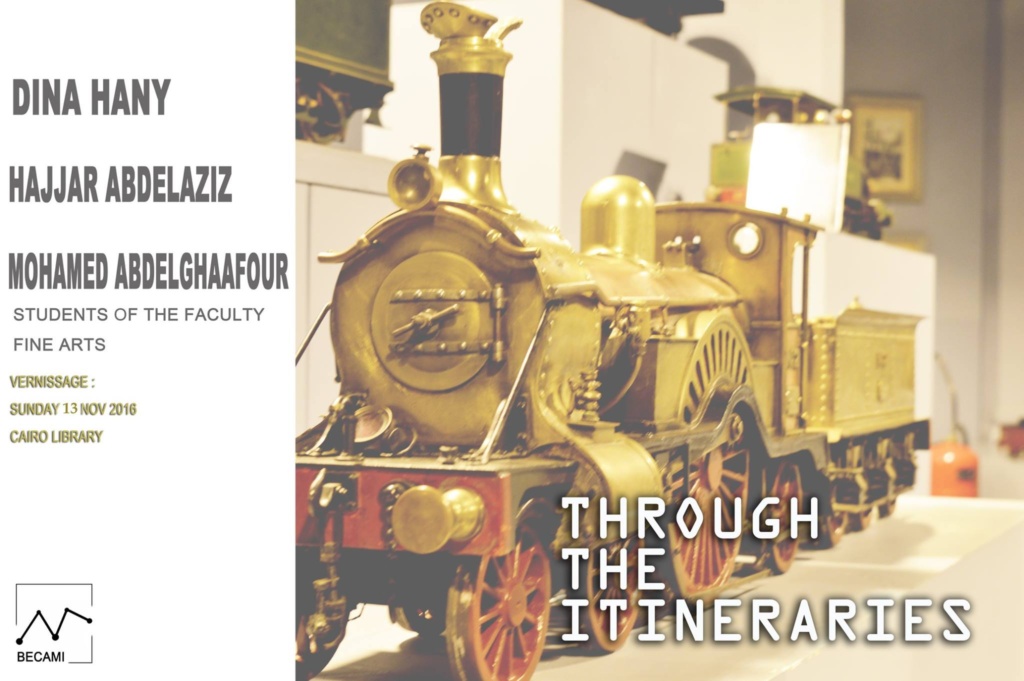
The opening seminar was accompanied with a photography exhibition made by the students of the Fine Arts Faculty (Helwan University). The exhibition was curated by Dr. Eman Abdou (Lecturer, Art Department, Fine Arts Faculty, Helwan University – BECAMI Researcher) with three students: Hajjar Abdul Aziz and Mohamed Abdelghaffour (3rd year, Architecture Department), and Dina Hany (Post graduate, Painting Department). Twenty photographs were exhibited with architectural and artistic views from the BECAMI Museums. The photographs were diverse and presented objects from the collections as well as the hidden architecture. The Exhibition re-presented the Museums to the public from a new angle engaging them emotionally in a rich visual experience.


